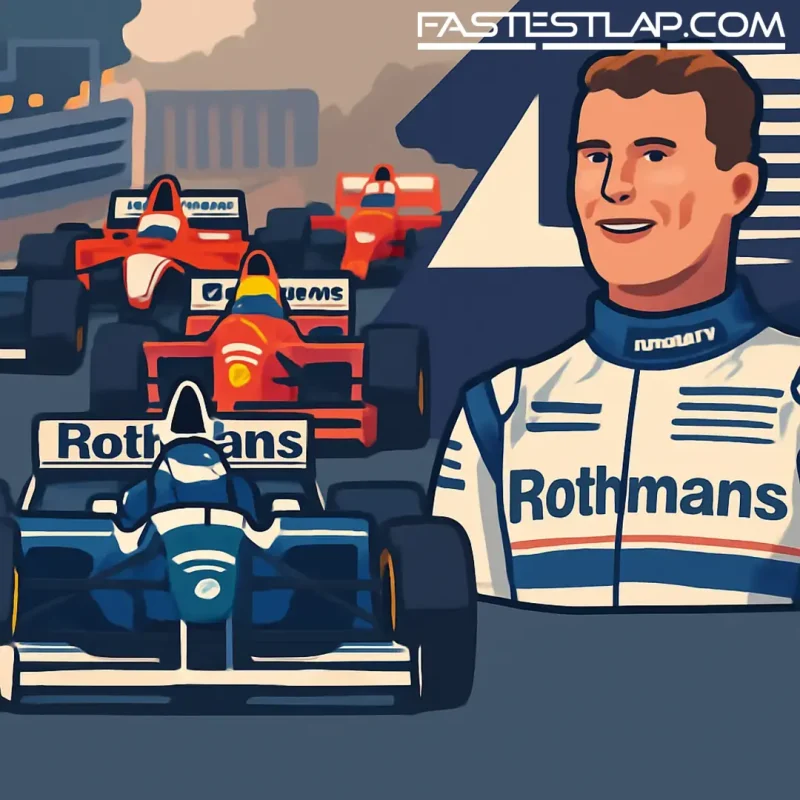Thirty years on, the memory still crackles with adrenaline for David Coulthard: Estoril, 1995, the first time everything finally lined up. A pole that stuck, a start that bit, a three-stop charge that felt like qualifying laps strung together, and a seven‑second cushion over Michael Schumacher at the flag. On that late-September afternoon, Williams’ young understudy became a Grand Prix winner.
Coulthard didn’t stroll to F1’s front door; he was thrown through it. Williams’ long-time test driver stepped into Ayrton Senna’s seat after Imola 1994, a decision born of tragedy and executed with ruthless speed. He arrived alongside Damon Hill, with Nigel Mansell dipping in later that year, and a spotlight that could’ve scalded anyone not already hardened by thousands of test kilometres in the FW16.
“It was a baptism of fire,” he reflected, speaking to PlanetF1.com. He’d been a familiar face at Grove since 1992, testing for Mansell, Alain Prost and then Senna. The upside? He wasn’t walking into a stranger’s garage. “I was very integrated into the team,” he said. The pressure, surprisingly, didn’t crush him. “It was just an opportunity.” He qualified ninth for his debut; Hill stuck it on the front row. A marker laid, but not yet a statement.
Even getting to that point was precarious. In early 1994, Coulthard was scratching together budget for Formula 3000 and figured he might only last a couple of races. Then came Silverstone’s F3000 opener—on the day after Senna’s death—and a call from Frank Williams that changed everything. Would he have reached F1 without it? “Probably not,” he admitted. Fate has heavy fingerprints on his story.
The 1994 Williams was fast and, in the beginning, a touch treacherous. “Quick, but tricky,” he said. Senna had taken poles in the first three rounds; Mansell would later win the season finale in Adelaide. Coulthard showed speed too—he led at Monza before team instructions shuffled him behind Hill, only for the car to splutter dry at Parabolica on the final lap. There were podiums, and there were rookie bruises.
The next season was his true apprenticeship. The FW17 could fly but fray at the edges. Missteps bit—spinning off on the formation lap from pole at the Nürburgring, the Monza restart that led to a seized front upright. He’s honest about it: part inexperience, part bad luck. In today’s hyper-analysed F1, he reckons that kind of bedding-in might’ve been deemed unforgivable. Back then, you could still be, as he put it, a “naive village boy” learning on the job.
Then came the upgrade that changed the tune. Williams arrived in Portugal with the FW17B, an Adrian Newey/Patrick Head remix designed to calm the car without clipping its wings. One clever tweak stood out: a reshaped, load-bearing wishbone that shrouded the driveshaft—an aero gift, deployed only for qualifying. “We put it on for quali, stuck it on pole, then took it off for the race,” Coulthard recalled with a grin.
Strategy? Pure aggression. Three stops, eyes forward. Coulthard’s fastest lap came on Lap 2—the first full-blooded lap of his race. He launched cleanly, had Schumacher filling the mirrors, and pushed until his lungs burned. “By Lap 8 or 9, I was exhausted,” he said. Then the Benetton started to fade in his mirrors, and the afternoon became manageable. Not easy—never easy—but controlled. When the flag fell, the 21st start of his career delivered pole, win, and fastest lap. Autosport’s headline—“At last!”—wasn’t subtle, but it wasn’t wrong.
Success bred swagger. After Monza and Estoril poles, came more at the Nürburgring and Aida, even as the odd mistake still nipped at his heels. Crucially, the win ended the second-guessing. “You don’t know how easy it is to win until you win,” he said. Once you do, it snaps everything into focus. And without that breakthrough, he believes, good drivers can spiral—frustration chewing away until the door shuts for good.
Coulthard’s Williams stint ended with the 1995 season, Jacques Villeneuve waiting in the wings and McLaren beckoning for 1996. Before that curtain fell, there was the small matter of Adelaide’s notorious brush with the pit wall—an expensive lesson and the kind of sting that stays with you even as you laugh about it later.
He finished his career with 13 Grand Prix wins and the kind of longevity that only comes with both speed and substance. But Estoril remains the moment everything started to make sense—a day when a test driver turned stand-in took command of a race against the era’s defining force and discovered, properly, what he could be.
The sport around him has changed beyond recognition since then. Strategy has gone from “how much fuel and when?” to modelling a thousand scenarios in real time. Media has multiplied. Patience has thinned. Yet the essence of a first win hasn’t changed a bit. It still unlocks a driver. It still rewires belief. And it still makes a career feel possible.
For Coulthard, that process began at Portugal’s sweeping old amphitheatre, in a car fine-tuned by one of the greatest design teams F1 has known, with a plan that asked for flat-out laps until the tank ran dry. Thirty years later, you can still hear it in his voice: the relief, the pride, the hint of surprise. A career forged in a moment that, even now, feels like it came at exactly the right time.




